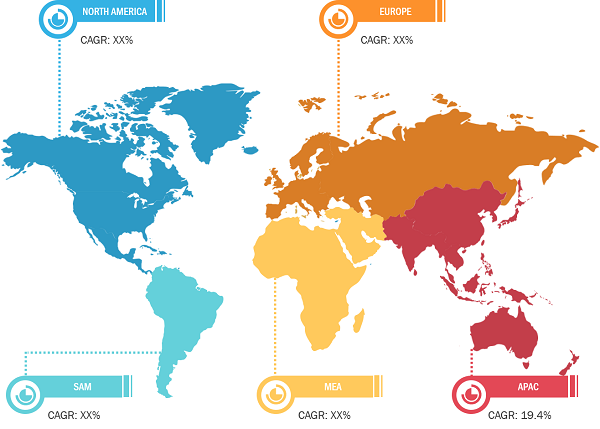Rising Adoption of VCSEL for 3D Sensing Applications Boosts Vertical Cavity Surface Emitting Laser (VCSEL) Market Growth
According to our latest study on “Vertical Cavity Surface Emitting Laser (VCSEL) Market Forecast to 2030 – COVID-19 Impact and Global Analysis – by Type, Material, Data Rate, Wavelength, Application, and End-use Industry,” the market size was valued at US$ 1.361 billion in 2022 and is projected to reach US$ 4.663 billion by 2030; it is estimated to record a CAGR of 17.0% from 2023 to 2030.
VCSELs are used widely as light sources in 3D sensing applications. 3D sensing technologies are used in various industries such as consumer electronics, medical, industrial, and automotive to gain high precision and accuracy for the required task. The technologies are used in cameras, commonly in smartphones, automobiles, drones, and robots, to scan and render objects in 3D. In consumer electronics such as smartphones, VCSEL is widely used for facial recognition and gesture control applications. In industrial automation, VCSEL is used for accurate sensing technologies. It is also employed in virtual reality and gaming applications. Thus, the growth of these industries propels the requirement for 3D sensing technologies, positively influencing the demand for VCSEL.
Vertical Cavity Surface Emitting Laser (VCSEL) Market – by Region, 2023 and 2030
Vertical Cavity Surface Emitting Laser (VCSEL) Market Size and Forecast (2021 - 2031), Global and Regional Share, Trend, and Growth Opportunity Analysis Report Coverage: By Type (Single Mode and Multi-Mode), Material (Gallium Arsenide (GaAs), Indium Phosphide (InP), and Others), Data Rate (Up to 10 GBPS, 10.1 to 25 GBPS, and Above 25 GBPS), Wavelength (Red, Near Infrared (NIR), and Short Wave Infrared (SWIR)), Application (Sensing, Data Communication, Industrial Heating & Printing, and Others), and End-use Industry (Mobile & Consumer, Telecom & Infrastructure, Industrial, Defense & Aerospace, Medical, and Automotive & Mobility), and Geography
Vertical Cavity Surface Emitting Laser Market Scope by 2031
Download Free Sample
Source: The Insight Partners Analysis
The use of VCSEL-based imaging increases the power and wavelength for 3D sensing. Further, it is considered an ideal solution for face and gesture recognition. Its ability to produce high-power outputs makes it an optimal solution in robotics and autonomous vehicle application. Such benefits of VCSEL encourage new product launches and contribute to its demand, which drives the Vertical Cavity Surface Emitting Laser (VCSEL) Market growth.
The Vertical Cavity Surface Emitting Laser (VCSEL) Market is segmented on the basis of type, material, data rate, wavelength, application, and end-use industry. Based on type, the VCSEL Market is bifurcated into single mode and multi-mode. Based on material, the VCSEL Market is segmented into gallium arsenide (GaAs), indium phosphide (InP), and others. By data rate, the VCSEL Market is categorized into up to 10 gbps, 10.1 to 25 gbps, and above 25 gbps. Based on wavelength, the Vertical Cavity Surface Emitting Laser (VCSEL) Market is categorized into red, near infrared (NIR), and shortwave infrared (SWIR). Based on application, the VCSEL Market is categorized into sensing, data communication, industrial heating & printing, and others. Based on end-use industry, the VCSEL Market is categorized into mobile & consumer, telecom & infrastructure, industrial, defense & aerospace, medical, and automotive & mobility. By region, the Vertical Cavity Surface Emitting Laser (VCSEL) Market is segmented into North America, Europe, Asia Pacific, the Middle East & Africa, and South America.
Impact of COVID-19 Pandemic on Vertical Cavity Surface Emitting Laser (VCSEL) Market Growth
The COVID-19 pandemic impacted many segments of the economy. During the COVID-19 pandemic, the production facilities of electrical, electronics, and semiconductors were temporarily shut down due to the slowdown and unavailability of the workforce worldwide. Hence, the Vertical Cavity Surface Emitting Laser (VCSEL) Market witnessed a slight decline in the demand for VCSEL, leading to the vendors' lower revenue generation.
One of the key industries to use VCSEL technology is the smartphone sector, which has faced disruptions in production. Further, the pandemic impacted the growth of 5G, as delays in the manufacturing and production of smartphones and reduced demand hindered the development of affordable 5G smartphones. This increased the use of VCSEL technology. However, the onset of the COVID-19 pandemic hampered the mass-scale production of VCSEL, which decreased its demand in the market.
Also, the COVID-19 pandemic led to several long-term and short-term impacts on the consumer industry. The Vertical Cavity Surface Emitting Laser (VCSEL) Market has experienced a significant drop in demand due to the slowdown of operations in the end-user industries across the world. However, the production restarted after the ease of restrictions. As a result, the demand for cheaper communication and IT increased in developing as well as developed countries, which fueled the Vertical Cavity Surface Emitting Laser (VCSEL) Market size growth.
Lumentum Holdings, Coherent Corp, Trumpf, Broadcom Inc., and Ams-Osram AG are a few of the key players operating in the VCSEL market.
Contact Us
Phone: +1-646-491-9876
Email Id: sales@theinsightpartners.com